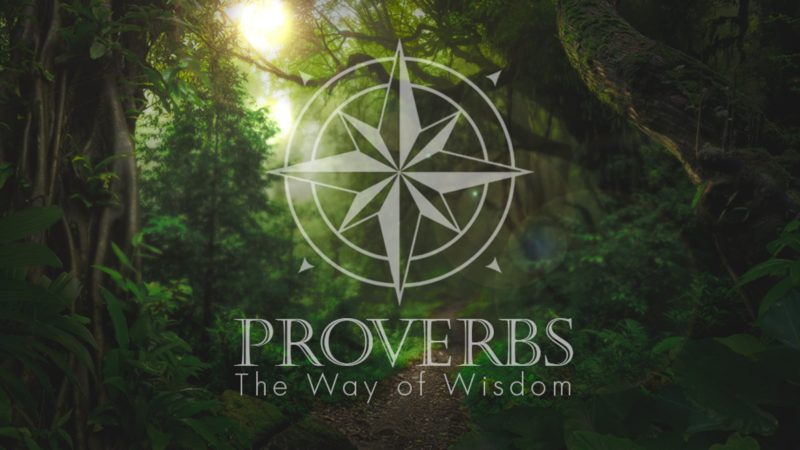The book of Proverbs begins with 10 lessons of wisdom (Ch 1-9). Here in this blog post we will examine lesson # 6. It begins with the familiar address, “My son.” The main theme in this lesson has to do with “the path,” a dominant metaphor in this biblical book. This theme is reflected in the title of our sermon series for Proverbs, “The Way of Wisdom.” The topography of Israel with its craggy hills, rocky cliffs, dark shadowy trails and treacherous pits would provide a vivid word picture for the son.
Notice the words “way” (v 11, 14, 19), “tracks” (v 11), “step” (v 12), “path” (v 14, 18), “lead” (v 11), “walk” (v 12), “run “v 12), “tripped up” (v 12, 16), “stop” (v 13), “enter” (v 14), “take a step” (v 14), “traverse” (v 15), “turn aside” and “pass on” (v 15). There are two paths described in this lesson, the way of wisdom (v 1-13) and the path of the wicked (v 14-17), followed by a concluding summary (v 18-19).
Listen, my son, accept what I say,
and the years of your life will be many.
I instruct you in the way of wisdom
and lead you along straight paths.
When you walk, your steps will not be hampered;
when you run, you will not stumble.
Hold on to instruction, do not let it go;
guard it well, for it is your life.
(Prov 4:10-13, NIV)
The “way of wisdom” is the book of Proverbs is not some abstract philosophy, it is a metaphor for one’s ongoing practical lifestyle. Each step represents a decision to conduct one’s self in a consistent manner. The wise lifestyle is likened a road that has come into existence because other godly people have walked this ancient and proven path before in obedience to God’s word. The way of wisdom is straight, safe, and it will lead the son to his divine destiny.
On the other hand, the way of the wicked is hard, it brings fatigue, it contains obstacles (a metaphor for debilitating moral consequences), and it will lead to ruin…
Do not set foot on the path of the wicked
or walk in the way of evildoers.
Avoid it, do not travel on it;
turn from it and go on your way.
For they cannot rest until they do evil;
they are robbed of sleep till they make someone stumble.
They eat the bread of wickedness
and drink the wine of violence.
(Prov 4:14-17, NIV)
Notice here that the wicked “cannot rest” until they do evil. OT scholar Bruce Waltke states that Solomon, “graphically represents their evil state of mind by representing them as ‘evilholics.'” (a) Sin is part of their daily diet. They have lost the battle within. Mr. Hyde has conquered Dr. Jekyl. The way of the wicked leads to a frightening conclusion. The two paths couldn’t be more different, they are like night and day.
The path of the righteous is like the morning sun,
shining ever brighter till the full light of day.
But the way of the wicked is like deep darkness;
they do not know what makes them stumble.
(Prov 4:18-19, NIV)
This poetic metaphor of light and dark, day and night, provides a profound closing illustration. In the early morning, the day begins with what’s called “first light,” then the sun will come up and it will grow stronger and stronger and brighter and brighter in its intensity throughout the day. Solomon tells us that is what a life of righteousness is like. It starts dim but grows stronger throughout life. It doesn’t fade. On the other hand, there are a lot of exploits of the wicked that are done in youth that are wrong, but at the time seem flashy and “cool.” College students think it’s fun to party, and sleep around or violate the law. But, that kind of lifestyle, though it starts out as a flash in the pan, over a period of time it grows weaker and weaker in is attractiveness through the years, doesn’t it? Not the righteous, they’re different. The way of wisdom doesn’t start out really popular, instead it starts with just a small light, but then as life goes on, when it comes tot he wise, their character and reputation just gets brighter and brighter until the full day. The wicked on the other hand start out at dusk and then their way gets darker and darker until it is pitch black. The righteous life is dim at first, it is not very flashy or impressive, but over time a life lived with wisdom and integrity becomes brilliant and attractive. That is what Solomon wants his son to become. This occurs by following the way of wisdom. The wise person will see the connection between choices and consequences, the wicked will never understand that or learn.
The Lesson:
The lesson reminds me of the words of this well-known poem by Robert Frost:
Two roads diverged in a wood, and I –
I took the one less traveled by,
And that has made all the difference.
We must turn away from the way of the wicked. There are no shortcuts, and it may feel slow as you only take one step at a time, still at the end of your life, you will end up worlds apart from the wicked.
Choose the Way of Wisdom.
Next we will examine Lesson # 7.
The Ten Lessons of Wisdom:
- Introduction
- Lesson # 1: “Reject the Enticement of Sinners” (Prov 1:8-33) – Part 1
- Lesson # 1: “Reject the Enticement of Sinners” (Prov 1:8-33) Part 2
- Lesson # 2: “Diligently Seek Wisdom … and You Will Experience Her Protective Benefits.” (Prov 2:1-22)
- Lesson # 3: “Live before God with Consistency.” (Prov 3:1-12)
- Lesson # 4: “Wisdom is a Tree of Life.” (Prov 3:13-35)
- Lesson # 5: “Your Spiritual Inheritance Comes With a Price.” (Prov 4:1-9)
- Lesson # 6: “Choose the Way of Wisdom.” (Prov 4:10-19)
- Lesson # 7: “Guard your Heart!” (Prov 4:20-27)
- Lesson # 8: “Flee from Immorality!” (Prov 5:1-23)
- Lesson # 9: “Avoid three Kinds of Fools: “The Swindler,” “The Sluggard” and “The Sociopath.”” (Prov 6:1-19)
- Lesson # 10: “If You Play With Fire, You Will Get Burned.” (Prov 6:20-35)
- Conclusion: Two Invitations from Wisdom and Folly (Prov 7:1-9:18) – Part 1
- Conclusion: Two Invitations from Wisdom and Folly (Prov 7:1-9:18) – Part 2
- Conclusion: Two Invitations from Wisdom and Folly (Prov 7:1-9:18) – Part 3
REFERENCES:
(a) Bruce Waltke, The Book of Proverbs: Chapters 1-15 (Grand Rapids: Eerdmans, 2005), 286.





